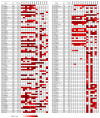Identifications of Surfactin-Type Biosurfactants Produced by Bacillus Species Isolated from Rhizosphere of Vegetables
- PMID: 36770839
- PMCID: PMC9919572
- DOI: 10.3390/molecules28031172
Identifications of Surfactin-Type Biosurfactants Produced by Bacillus Species Isolated from Rhizosphere of Vegetables
Abstract
Surfactins are cyclic lipopeptides consisting of a β-hydroxy fatty acid of variable chain length and a peptide ring of seven amino acids linked together by a lactone bridge, forming the cyclic structure of the peptide chain. These compounds are produced mainly by Bacillus species and are well regarded for their antibacterial, antifungal, and antiviral activities. For their surfactin production profiling, several Bacillus strains isolated from vegetable rhizospheres were identified by their fatty acid methyl ester profiles and were tested against phytopathogen bacteria and fungi. The isolates showed significant inhibition against of E. amylovora, X. campestris, B. cinerea, and F. culmorum and caused moderate effects on P. syringae, E. carotovora, A. tumefaciens, F. graminearum, F. solani, and C. gloeosporioides. Then, an HPLC-HESI-MS/MS method was applied to simultaneously carry out the quantitative and in-depth qualitative characterisations on the extracted ferment broths. More than half of the examined Bacillus strains produced surfactin, and the MS/MS spectra analyses of their sodiated precursor ions revealed a total of 29 surfactin variants and homologues, some of them with an extremely large number of peaks with different retention times, suggesting a large number of variations in the branching of their fatty acid chains.
Keywords: Bacillus; HPLC-HESI-MS/MS; biosurfactant; surfactin.
Conflict of interest statement
The authors declare no conflict of interest.
Figures






Similar articles
-
High-Frequency Occurrence of Surfactin Monomethyl Isoforms in the Ferment Broth of a Bacillus subtilis Strain Revealed by Ion Trap Mass Spectrometry.Molecules. 2018 Sep 1;23(9):2224. doi: 10.3390/molecules23092224. Molecules. 2018. PMID: 30200458 Free PMC article.
-
Ion trap mass spectrometry of surfactins produced by Bacillus subtilis SZMC 6179J reveals novel fragmentation features of cyclic lipopeptides.Rapid Commun Mass Spectrom. 2016 Jul 15;30(13):1581-90. doi: 10.1002/rcm.7592. Rapid Commun Mass Spectrom. 2016. PMID: 27321846
-
Effects of Different Cultivation Parameters on the Production of Surfactin Variants by a Bacillus subtilis Strain.Molecules. 2018 Oct 18;23(10):2675. doi: 10.3390/molecules23102675. Molecules. 2018. PMID: 30340314 Free PMC article.
-
Research advances in the identification of regulatory mechanisms of surfactin production by Bacillus: a review.Microb Cell Fact. 2024 Apr 2;23(1):100. doi: 10.1186/s12934-024-02372-7. Microb Cell Fact. 2024. PMID: 38566071 Free PMC article. Review.
-
Chemical structure, property and potential applications of biosurfactants produced by Bacillus subtilis in petroleum recovery and spill mitigation.Int J Mol Sci. 2015 Mar 3;16(3):4814-37. doi: 10.3390/ijms16034814. Int J Mol Sci. 2015. PMID: 25741767 Free PMC article. Review.
Cited by
-
A review on surfactin: molecular regulation of biosynthesis.Arch Microbiol. 2023 Aug 21;205(9):313. doi: 10.1007/s00203-023-03652-3. Arch Microbiol. 2023. PMID: 37603063 Review.
-
Microplastics influence on herbicides removal and biosurfactants production by a Bacillus sp. strain active against Fusarium culmorum.Sci Rep. 2023 Sep 5;13(1):14618. doi: 10.1038/s41598-023-41210-5. Sci Rep. 2023. PMID: 37670040 Free PMC article.
References
-
- Chen W.-C., Juang R.-S., Wei Y.-H. Applications of a lipopeptide biosurfactant, surfactin, produced by microorganisms. Biochem. Eng. J. 2015;103:158–169. doi: 10.1016/j.bej.2015.07.009. - DOI
-
- From C., Hormazabal V., Hardy S.P., Granum P.E. Cytotoxicity in Bacillus mojavensis is abolished following loss of surfactin synthesis: Implications for assessment of toxicity and food poisoning potential. Int. J. Food Microbiol. 2007;117:43–49. doi: 10.1016/j.ijfoodmicro.2007.01.013. - DOI - PubMed
MeSH terms
Substances
Grants and funding
LinkOut - more resources
Full Text Sources

